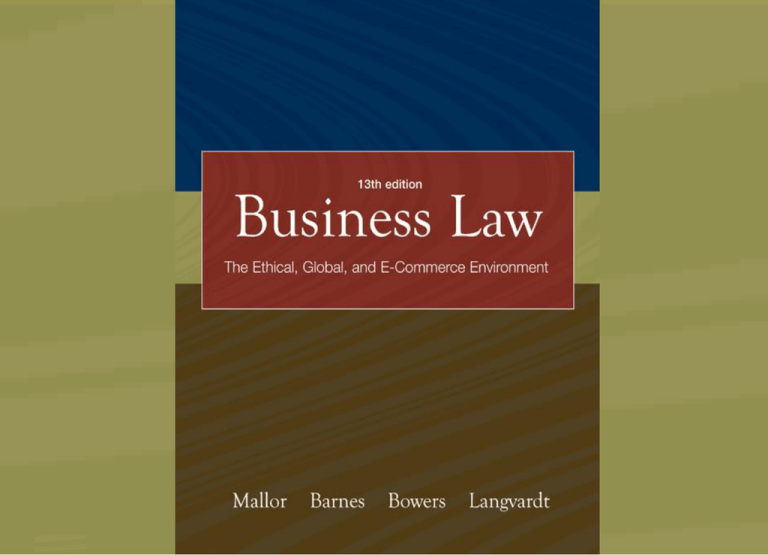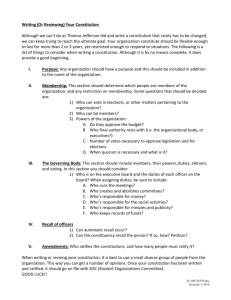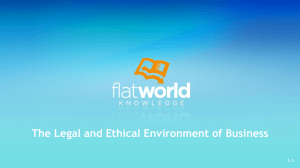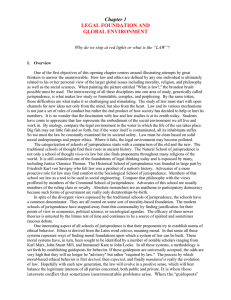
P A R T
1
Foundations of American Law
The Nature of Law
The Resolution of Private Disputes
Business and The Constitution
Business Ethics, Corporate Social
Responsibility, Corporate Governance,
and Critical Thinking
McGraw-Hill/Irwin Business Law, 13/e
© 2007 The McGraw-Hill Companies, Inc. All rights reserved.
C H A P T E R
1
The Nature of Law
“The sacred rights of mankind . . . are written, as with a sun beam
in the whole volume of human nature, . . . and can never be
erased or obscured by mortal power.”
Alexander Hamilton, 1775
Learning Objectives
Types and sources of law
Important legal doctrines
Classification of law
Jurisprudence and legal reasoning
Statutory interpretation
Limitations on judicial power
1-4
Types or Sources of Law
Federal,
state, and tribal level:
U.S. Constitution: establishes governmental
structure, specific rights and duties
Statute: enacted by legislative body to
regulate conduct
Common Law: case law (judge-made)
Administrative Law: agency rules to
implement enforcement of statutes
1-5
Types or Sources of Law
Issued
at chief executive level:
Executive Order: under limited powers
Treaty: with other nations, by the U.S.
president on behalf of the nation, and
ratified by the U.S. Senate
1-6
Important Doctrines
Stare Decisis (let the decision stand)
Equity
Doctrine of precedent applied in common law
Applied by the judiciary to achieve justice
when legal rules would produce unfair results
Federal supremacy:
1-7
Rule of priority for conflicts between laws that
holds U.S. Constitution the supreme law of
land (Art. VI, Sec. 2, U.S. Constitution)
Classification of Law
Criminal law establishes duties to society
Government charges and prosecutes
defendant, who is found guilty or innocent
Civil law establishes duties between private
parties
1-8
Plaintiff sues defendant for monetary
damages or equitable relief
Classification of Law
Substantive law establishes rights and duties
of people in society
Procedural law establishes how to enforce
those rights and duties
Public law refers to the relationship between
governments and private parties
Private law refers to the regulation of conduct
between private parties
1-9
Jurisprudence
Jurisprudence refers to the philosophy of law
as well as the collection of laws
Legal positivism: law is the command of a
recognized political authority
Natural law: universal moral rules bind all
people whether written or unwritten
1 - 10
See U.S. v. Lynch
Jurisprudence
Legal realism defines law as the behavior of
the judiciary as they rule on matters within
the legal system
Sociological jurisprudence unites theories that
examine law within its social context
1 - 11
Legal Reasoning
Basically deductive, with the legal rule as the
major premise and facts as the minor premise
Court may stand on precedent or distinguish
prior case from current case
If precedent inapplicable, new rule developed
1 - 12
See Hagan v. Coca-Cola Bottling Co.
Statutory Interpretation
Plain meaning rule: court applies statute
according to usual meaning of the words
A court examines legislative history and
purpose when plain meaning rule is
inadequate
See Hyatt v. Anoka Police Department
See General Dynamics Land Systems, Inc. v. Cline
Courts may interpret a statute in light of a
general public purpose or public policy
1 - 13
Limitations on Judicial Power
Courts limited to
deciding existing
cases or controversies
Parties must have
standing (direct
interest in the
outcome) to sue
Do plants and animals
have legal standing?
1 - 14
Global Business Environment
Courts may faced with
treaty interpretation
The U.S. Supreme Court
interpreted The Warsaw
Convention in Olympic
Airways v. Husain
How would you have
interpreted the treaty
language?
1 - 15
“The carrier shall be liable
for damage sustained in the
event of the death or
wounding of a passenger or
any other bodily injury
suffered by a passenger, if
the accident which caused
the damage so sustained
took place on board the
aircraft or in the course of
the operations of embarking
or disembarking.”
Warsaw Convention, Art. 17
Test Your Knowledge
True=A, False = B
1 - 16
The Constitution, statutes, and case law are
sources of law in the United States
Agency regulations, presidential orders, and
treaties are sources of law in the United States
Stare decisis refers to the doctrine of equity
The Supremacy Clause states that the U.S.
Constitution is the supreme law of the land
Test Your Knowledge
True=A, False = B
1 - 17
Civil law establishes the duties an individual
has to keeping a civil society
Substantive law establishes how to enforce
the rights and duties of people in society
Jurisprudence refers to the philosophy of law
as well as the collection of laws
Legal reasoning is basically inductive
Test Your Knowledge
Multiple Choice
The plain meaning rule means that the
court applies a statute
(a) according to the unique or special meaning
of words
(b) according to usual meaning of the words
(c) according to public policy and legislative
purpose
1 - 18
Test Your Knowledge
Multiple Choice
Courts are:
(a) Limited to hearing existing cases or
controversies
(b) Limited to hearing cases in which the
plaintiff has standing (a direct interest in the
outcome)
(c) Unlimited in types of cases they may hear
(d) All of the above
(e) Both A & B
1 - 19
Thought Question
What do you think the authors of the U.S.
Constitution would think about current legal
issues in our society?
1 - 20









